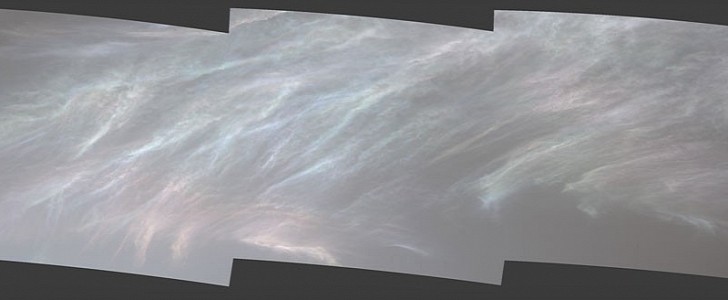The NASA Curiosity rover has captured some stunning pictures of ice-filled clouds on Mars. Although these shimmery formations are rare to spot in the very thin atmosphere of the Red Planet around this time of the year, they made an appearance higher and earlier than expected.
The phenomenon started to happen two years (or one Martian year) ago when researchers observed that clouds began to form earlier than the previous years. According to NASA, these clouds are most commonly found near the planet's equator during the coldest months of the year, when Mars is the furthest from the Sun.
This time, researchers were prepared to study the early-forming clouds, but they didn’t observe just that. While most Martian clouds are found at about 37 miles (60 kilometers) high and are composed of water ice, the ones captured by Curiosity were at an even higher altitude. This means that they are probably made of carbon dioxide or dry ice since temperatures are extremely low up there.
Using its Mast Camera (MastCam) – an instrument located on top of its "head" – Curiosity took both color and black-and-white photographs of the formations. The pictures were taken after sunset when the Sun illuminated the ice crystals from the clouds, making them appear as glowing stripes in the sky.
Back on Earth, we have a similar phenomenon called noctilucent clouds, or night-shining clouds that form at 50 miles (80 km) above the planet’s surface. They are usually visible when twilight sets, specifically when the Earth's shadow falls on the lower layers of the atmosphere.
On Mars, Curiosity did not take only photos of shiny clouds but also iridescent ones that show stunning hues of red and blue. “If you see a cloud with a shimmery pastel set of colors in it, that’s because the cloud particles are all nearly identical in size,” notes Mark Lemmon, an atmospheric scientist with the Space Science Institute in Boulder, Colorado.
“That’s usually happening just after the clouds have formed and have all grown at the same rate.”
NASA is currently working to determine which of Curiosity's recent images depict water-ice clouds and which depict dry-ice ones. Such photographs play a significant role in helping researchers understand how clouds form and grow on Mars and why these early-arriving clouds are different than the ones documented before.
This time, researchers were prepared to study the early-forming clouds, but they didn’t observe just that. While most Martian clouds are found at about 37 miles (60 kilometers) high and are composed of water ice, the ones captured by Curiosity were at an even higher altitude. This means that they are probably made of carbon dioxide or dry ice since temperatures are extremely low up there.
Using its Mast Camera (MastCam) – an instrument located on top of its "head" – Curiosity took both color and black-and-white photographs of the formations. The pictures were taken after sunset when the Sun illuminated the ice crystals from the clouds, making them appear as glowing stripes in the sky.
Back on Earth, we have a similar phenomenon called noctilucent clouds, or night-shining clouds that form at 50 miles (80 km) above the planet’s surface. They are usually visible when twilight sets, specifically when the Earth's shadow falls on the lower layers of the atmosphere.
On Mars, Curiosity did not take only photos of shiny clouds but also iridescent ones that show stunning hues of red and blue. “If you see a cloud with a shimmery pastel set of colors in it, that’s because the cloud particles are all nearly identical in size,” notes Mark Lemmon, an atmospheric scientist with the Space Science Institute in Boulder, Colorado.
“That’s usually happening just after the clouds have formed and have all grown at the same rate.”
NASA is currently working to determine which of Curiosity's recent images depict water-ice clouds and which depict dry-ice ones. Such photographs play a significant role in helping researchers understand how clouds form and grow on Mars and why these early-arriving clouds are different than the ones documented before.






